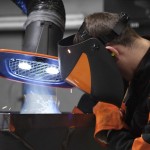Responsibility in occupational health and safety: Who bears it, who is liable?
It is the worst-case scenario: In 2010, an apprentice injured himself in the production department of a company in the Emsland region of Germany so severely that he died. A tragic accident? The Osnabrück Regional Court, which heard the case three years later, holds the managers in the company responsible and sentences the two managing directors, an authorised signatory, the head of the maintenance department and the trainer of the deceased to fines. The managing directors even receive a six-month suspended prison sentence.
In another case, the Frankfurt Regional Court ruled similarly: Because an employee of a chemical company accidentally discharged hydrochloric acid into the Main River, the judges sentenced the chairman of the board, members of the board, a plant manager and a department manager to fines. The employee did not know that a valve was not allowed to be opened during operation. This example also shows how courts hierarchically weight the responsibility for Protective Welding Equipment within a company.
Only persons are legally liable to prosecution, not companies
To do this, one must know: Legal persons under both private and public law are not liable in tort and thus not criminally liable. A limited liability company, a public limited company or even a municipality cannot be held liable in the event of an accident, but their representatives can. According to §13 ArbSchG (Occupational Health and Safety Act), the legal representatives of a legal entity are legally liable to prosecution. First of all, these are those who run a company: Owner, limited liability company managing director or chairman of the board. They assume liability for violations of the Occupational Health and Safety Act.
Delegating duties to managers
However, company management can delegate OSH duties to managers. These must then be documented and described in detail. In addition, the employer should exercise some care in the selection process. This is because not every manager has the knowledge and skills to be able to carry out the assigned duties. Ultimately, the supervision and control of occupational health and safety is always the responsibility of the employer. He alone is responsible for this.
A managing director must therefore ensure that his managers, to whom he gives authority, also comply with the legal requirements of occupational health and safety in their areas of responsibility and sensitise their employees accordingly. For example, department or team leaders must ensure that appropriate personal protective equipment (PPE) is available and also worn in accordance with regulations. They must carry out risk assessments, instructions and safety measures. Incidentally, this obligation applies not only to the company’s own employees, but also to those from temporary employment agencies or external companies.
Employees have a duty to cooperate
The employees, in turn, have a duty to cooperate. They must complete training, wear protective equipment and use safety devices on machines. If they do not do so and are injured in the process, they are partly to blame. For example, the Siegen Regional Court dismissed a claim brought by a production employee against the manufacturer of a machine. The employee had improperly operated a spot welding machine that was not CE-marked. The operating company (employer) had wanted to make changes to the installation, which is why no CE marking had been made. However, the supervisor and thus the person authorised to issue instructions was able to credibly demonstrate in court that he had trained the employee on the machine in detail and had explicitly pointed out the dangers to him. The court concluded that the employee had acted with gross negligence and that the crushing injury was self-inflicted. The court did not examine the question of whether the buyer of the welding machine became the manufacturer himself as a result of the modifications. However, the employee appealed. The Higher Regional Court of Hamm ordered an expert opinion on the machine. The parties (manufacturer and employee) reached a settlement in which the manufacturer paid the employee 25,000 Euro without acknowledging any legal obligation. This settled all claims arising from the accident. However, a further complaint by the employee against the employer was unsuccessful.
However, not only internal employees or managers are responsible for compliance with occupational health and safety, but also external service providers. If, for example, an engineer from an external company instructs employees of the own company in the operation of a new plant, this engineer – just like any other manager in the company – bears the responsibility for occupational health and safety.
Ignorance does not protect from punishment
As a general rule, each employee is responsible for occupational health and safety in accordance with his or her duties. Ignorance does not protect against punishment. Therefore, occupational health and safety should be systematically managed in a company and competences and responsibilities should be clearly regulated and documented at each hierarchical level.





